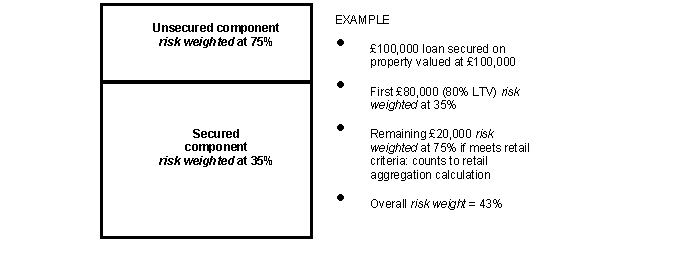|
Central government
|
Exposures to United Kingdom government or Bank of England in sterling
|
0%
|
|
|
3
|
3
|
3
|
|
3
|
3
|
|
|
3
|
3
|
3
|
|
Exposures to central governments or central banks of certain countries outside the UK3 in currency of that country
|
See next column
|
The risk weight is whatever it is under local law. See BIPRU 3.4.6 R for precise details.
|
|
3
|
3
|
|
|
Other exposures
|
100%
|
|
|
Regional/local governments
|
Exposures to the Scottish Parliament, National Assembly for Wales and Northern Ireland Assembly in sterling
|
0%
|
|
|
3
|
3
|
3
|
|
3
|
3
|
3
|
|
3
|
3
|
3
|
|
Exposures to local or regional governments of certain countries outside the UK3 in currency of that country
|
0%
|
See BIPRU 3.4.19 R for details of type of local/regional government covered.
See Note.3
|
|
Exposures to United Kingdom local/regional government in sterling3 if the exposure has original effective maturity of 3 months or less
|
20%
|
|
|
3
|
3
|
3
|
|
Exposures to local or regional governments of countries outside the UK3 in currency of that country if the exposure has original effective maturity of 3 months or less
|
20%
|
See Note.3
|
|
Other exposures
|
100%
|
|
|
PSE
|
Exposures to a PSE of the United Kingdom if that PSE is guaranteed by central government and if the exposure is in sterling3.
|
0%
|
BIPRU 3.4.24 R
describes the United KingdomPSEs covered3.
|
|
Exposures to PSE of a country outside the UK3 if that PSE is guaranteed by the country's central government and if the exposure is in currency of that country.
|
0%
|
See BIPRU 3.4.26 R and Note.3
|
|
Exposures to a PSE of the United Kingdom in sterling3 if the exposure has original effective maturity of 3 months or less
|
20%
|
|
|
3
|
3
|
3
|
|
Exposures to PSE of a country outside the UK3 in currency of that country if the exposure has original effective maturity of 3 months or less
|
20%
|
See Note3.
|
|
Other exposures
|
100%
|
|
|
Multilateral development banks
|
Exposures to multilateral development banks listed in paragraph (1) of the Glossary definition
|
0%
|
Simplified approach does not apply. Normal rules apply.
|
|
Other exposures
|
Various
|
Treated as an institution
|
|
EU
2, The3 International Monetary Fund and the Bank for International Settlements
2
|
|
0%
|
Simplified approach does not apply. Normal rules apply.
|
|
Institutions
|
Exposures to United Kingdominstitution in sterling with original effective maturity of three months or less
|
20%
|
|
|
3
|
3
|
3
|
|
3
|
3
|
|
|
3
|
3
|
3
|
|
Exposures to institution with a head office in a country outside the UK3 in the currency of that country with original effective maturity of three months or less
|
20%
|
See Note3.
|
|
Exposures to United Kingdominstitution in sterling with original effective maturity of over three months
|
50%
|
|
|
3
|
3
|
3
|
|
3
1
|
3
|
|
|
3
1
|
3
|
3
|
|
Exposures to institution with a head office in a country outside the UK3 in the currency of that country with original effective maturity of over three1 months
|
50%
|
See Note3.
|
|
Other exposures
|
100%
|
|
|
Corporates
|
|
100%
|
|
|
Retail exposures
|
|
75%
|
Simplified approach does not apply. Normal rules apply.
|
|
Mortgages on residential or commercial property
|
|
Various
|
Simplified approach does not apply. Normal rules apply.
|
|
Past due items
|
|
Various
|
Simplified approach does not apply. Normal rules apply.
|
|
High risk items
|
|
150%
|
Simplified approach does not apply. Normal rules apply.
|
|
Covered bonds
|
|
Various
|
Risk weights are based on the risk weight of issuer as described in BIPRU 3.4.110 R. The risk weight of the issuer for this purpose should be calculated under the simplified approach.
|
|
Securitisation
exposures
|
|
Generally 1250%. May look through to underlying exposures if BIPRU 9 allows.
|
Use the BIPRU 9rules for unrated exposures under the standardised approach
|
|
Short term exposures with rating
|
|
|
See BIPRU 3.4.112 R. Not applicable as uses ECAI ratings.
|
|
CIUs
|
May look through to underlying under BIPRU 3.4.123 R
|
Various
|
Simplified approach does not apply. Normal rules apply. May use simplified approach to underlying if simplified approach applies to underlying.
|
|
May use average risk weight under BIPRU 3.4.124 R
|
Various
|
Simplified approach does not apply. Normal rules apply. May use simplified approach to underlyings if simplified approach applies to underlying.
|
|
High risk under BIPRU 3.4.118 R
|
150%
|
Simplified approach does not apply. Normal rules apply.
|
|
Others
|
100%
|
|
|
Other items under BIPRU 3.2.9 R (16)
|
|
Various
|
Simplified approach does not apply. Normal rules apply.
|
|
Note3: The risk weight should not be lower than the risk weight that applies for national currency exposures of the central government of the third country in question under BIPRU 3.5. That means that this risk weight only applies if the third country is one of those to which BIPRU 3.4.6 R (Preferential risk weight for exposures of the central government of countries outside the UK3 that apply equivalent prudential standards) applies.
|
|
3
|
|
3
|




